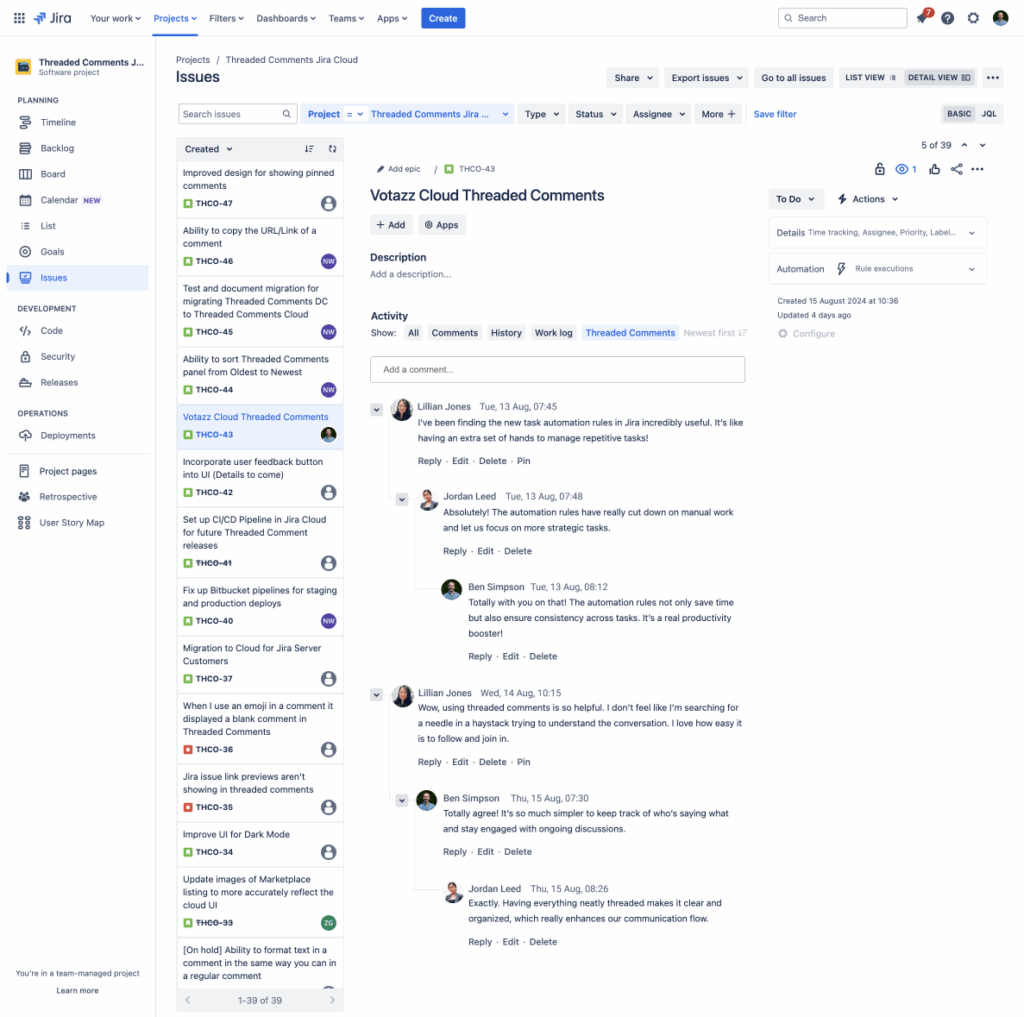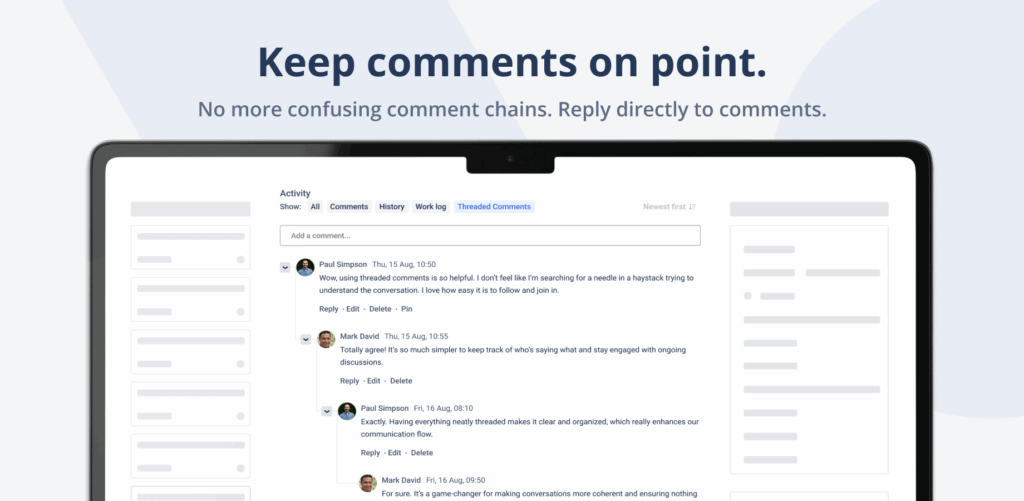How Teams Actually Use Threaded Comments in Jira: Real-World Scenarios That Save Hours Weekly
You know that moment when you’re scrolling through 47 comments on a Jira ticket, trying to figure out which response belongs to which question? Or when your teammate in Singapore asks a clarifying question about comment #23, but by the time you see it, there are already 15 more comments in between?
Yeah, we’ve been there too. That’s exactly why threaded comments matter more than most teams realize.
The Monday Morning Chaos: Sarah’s Story
Sarah, a product manager at a fintech startup, opens her laptop Monday morning. Her team spans San Francisco, London, and Bangalore. Over the weekend, a critical production issue spawned 62 comments across three Jira tickets.
In the main ticket alone, there are:
- Questions from the Bangalore team about the root cause
- Responses from London about potential fixes
- Customer impact assessments from San Francisco
- Approval requests mixed throughout
- Status updates that nobody can find anymore
Without threaded comments, Sarah spends 45 minutes just understanding what happened. With them? Each conversation branch stays contained. The root cause discussion, the customer impact thread, and the fix approval chain – all neatly separated and collapsible.
When Native Jira Comments Fall Short

Yes, Jira Cloud recently introduced basic threading, but here’s what teams discovered the hard way:
Limited Depth: Native threading goes one level deep. Real technical discussions? They need multiple levels. When your senior developer responds to a junior’s question, and then the architect jumps in with a different approach, and then QA raises a concern about that approach… you need proper nesting.
No Collapse Control: Can’t collapse threads you’ve already read. On tickets with hundreds of comments, you’re still scrolling endlessly.
Missing Notifications: Reply notifications aren’t granular enough. You get notified about everything or nothing, not just the threads you’re participating in.
Five Scenarios Where Threaded Comments Transform Your Workflow
1. The Multi-Issue Support Ticket

Picture this: A Jira Service Management ticket comes in. The customer reports three different problems in one request (because of course they do).
Without threading, your support engineer addresses issue #1, then issue #2 starts getting discussed, someone asks for clarification on issue #1, issue #3 gets mentioned, someone responds about issue #2… It’s chaos.
With proper threading:
- Issue #1 gets its own thread with troubleshooting steps
- Issue #2 has a separate branch where developers discuss the fix
- Issue #3 has a thread where the team decides it’s actually a feature request
- The customer gets clear, organized responses
2. The Architecture Decision Record
Your team is deciding between MongoDB and PostgreSQL for a new service. In a traditional Jira comment stream, you’d see:
Comment 35: “I think MongoDB would be better for our use case” Comment 36: “The daily standup is moved to 10 AM” Comment 37: “But PostgreSQL has better transaction support” Comment 38: “@John can you review my PR?” Comment 39: “What about the cost implications of MongoDB?”

Now imagine that same discussion with threading. The architecture debate stays in one collapsible thread. The standup note and PR review request don’t interrupt the technical discussion. When the CTO checks in two days later, they can expand just the architecture thread and see the complete discussion flow.
3. Code Review Approval Chains
Development teams discovered something interesting: threaded comments work brilliantly for approval workflows.
A developer completes a feature. They comment: “Ready for review.” Under that thread:
- QA responds with test results
- Security team adds their approval with conditions
- The developer responds to those conditions
- Final approval comes from the team lead
All in one neat thread. No more searching through comments to verify if all approvals were obtained. The entire approval chain is visible at a glance.
4. The Time Zone Handoff
Here’s a real scenario from a globally distributed team:
Tokyo team (Monday, 9 AM): Discovers a performance issue, starts investigation thread London team (Monday, 2 PM their time): Jumps into the same thread, adds findings New York team (Monday, 10 AM their time): Implements fix, updates the thread Tokyo team (Tuesday, 9 AM): Sees the entire conversation in one thread, confirms fix
Without threading? The Tokyo team returns to find 30+ mixed comments about the issue, a separate UI bug someone reported, and discussion about next sprint’s planning. Finding the performance issue resolution becomes a treasure hunt.
5. The Customer Escalation Documentary
When enterprise customers escalate issues, every comment matters. Legal might get involved. Executives want updates. Support, engineering, and product teams all contribute.
Threaded comments let you maintain separate streams:
- Technical investigation thread (for engineers)
- Customer communication thread (what we’re telling them)
- Internal strategy thread (how we’re handling this)
- Executive summary thread (quick updates for leadership)
Each stakeholder expands only what they need. No information overload. No missed critical updates.
The Hidden ROI Most Teams Miss
Let’s do quick math. Say your team has 20 people. Each person spends just 5 minutes per day untangling comment threads and finding relevant responses. That’s:
- 100 minutes daily
- 8.3 hours weekly
- 433 hours yearly
- Roughly 11 work weeks lost to comment confusion
And that’s conservative. We’ve seen teams report 15-20 minutes per person per day in comment navigation overhead.
Making the Switch: What Changes?
The beautiful part? Almost nothing changes in how your team works. They still comment normally. They just gain a “reply” option that creates threading. No training needed. No workflow disruption.
Teams typically report two phases:
Week 1: “Oh, this is nice. Comments are cleaner.” Week 4: “How did we ever live without this? Just found a critical approval from two weeks ago in seconds instead of minutes.”
Beyond the Basics: Power User Moves
Experienced teams developed these patterns:
The Decision Thread: Start major decisions with “DECISION THREAD: [topic]” – all discussion happens in replies. Decision made? Collapse and move on.
The Status Update Branch: Weekly status updates get their own thread. Stakeholders can quickly expand last week’s status without wading through everything else.
The Investigation Tree: Bug investigations branch naturally – main thread for findings, sub-threads for different hypotheses being tested in parallel.
When Threading Matters Most
After watching hundreds of teams adopt threaded comments, clear patterns emerged. You need threading most when:
- Your team spans 3+ time zones
- Tickets regularly get 20+ comments
- Multiple issues get discussed in single tickets
- You need approval audit trails
- External stakeholders (customers, vendors) participate in tickets
- You’re running Jira Service Management with complex support workflows
The Bottom Line
Threaded comments aren’t just about organization. They’re about preserving context, maintaining momentum, and respecting everyone’s time. They transform Jira from a chronological comment dump into a structured conversation platform.
Every team that’s tried going back to flat comments after using threading has the same reaction: “It feels like going from Slack back to email.” Once you experience the clarity of threaded discussions, the old way feels broken.
Ready to give your team back those 11 weeks per year? The 30-day trial costs nothing, takes minutes to set up, and your team will thank you by week two.
Because at the end of the day, your team’s discussions are too important to lose in the comment chaos. Every conversation deserves its own space to breathe, evolve, and conclude – without drowning out everything else.